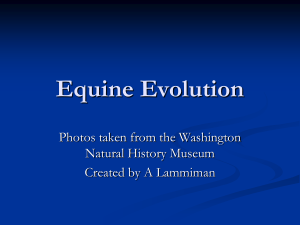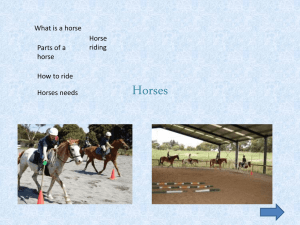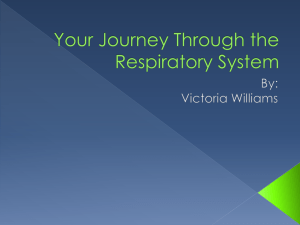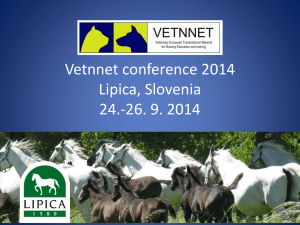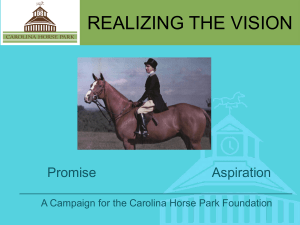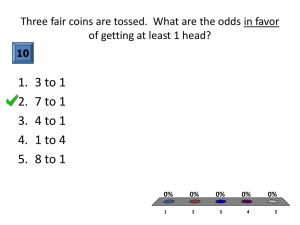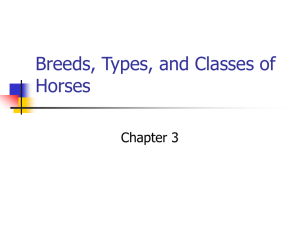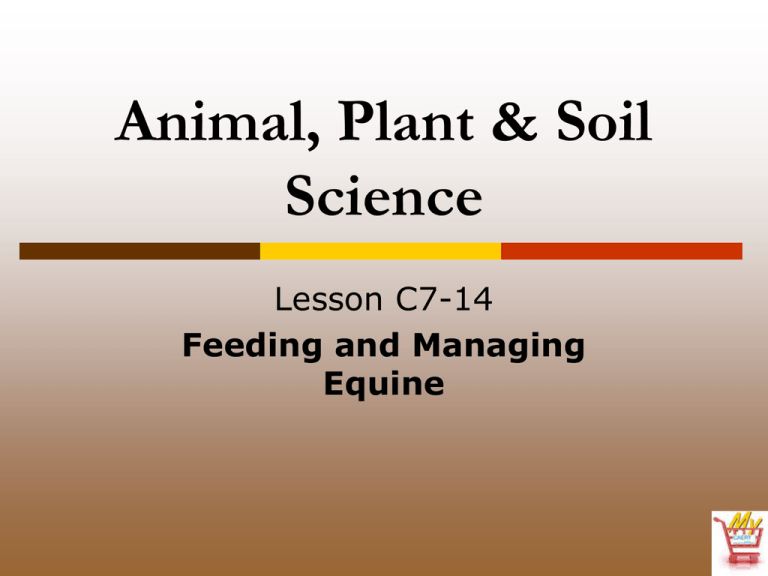
Animal, Plant & Soil
Science
Lesson C7-14
Feeding and Managing
Equine
Objectives
Examine reproductive management
practices of equine.
Describe the types of feedstuffs fed to
equine and analyze the nutritional
requirements of equine.
Objectives
Identify common diseases and
ailments that affect equine and
determine appropriate prevention and
treatment methods.
Describe proper tooth care and
determine the age of a horse by
examining its teeth.
Objectives
Identify the parts of a hoof, discuss
the proper care of a hoof, and
describe the job of a farrier.
Explain how to select a superior
horse.
Describe and demonstrate basic
horsemanship, training, and riding
techniques.
What reproductive management
practices are used in equine
production?
Several specific management practices are
involved in the care of the stallion and
mares during breeding, parturition, and
weaning time.
Horses have a lower
conception rate
compared to other
livestock.
Special attention and
care is a priority during this time.
What reproductive management
practices are used in equine
production?
A. The stallion is kept in a separate stall or
pens.
During breeding, the mare is brought to
the stallion, or a breeding barn/pen is
used.
Breeding pens are well equipped with
padding on the walls and a soft flooring
material.
1. There is a great risk of the animals
being injured during the breeding process.
Many breeding pens are well designed to
provide safety to the horses and their handlers.
What reproductive management
practices are used in equine
production?
2. When the stallion is not
breeding, it is important to provide a
roomy box stall and 2 to 3 acres of
pasture for exercise.
The stallion should be exercised on a
daily basis.
It is essential for the stallion to stay in good condition.
3. The stallion is evaluated on the number of live,
healthy foals that have been sired.
Many stud farms will evaluate the semen of stallions for
fertility, volume, and mobility.
Artificial insemination is used in some breeds of horses.
What reproductive management
practices are used in equine
production?
B. A mare should be at least three
years of age before breeding takes
place; therefore, she will be four years
of age when she delivers her first foal.
It is essential that the mare is
completely trained before breeding.
This will decrease the amount of stress and
activity for the mare.
Mares at three to fours years of age are more
mature, taller, and fully grown and are thus better
able to handle the breeding process.
Mares can foal up to 14 to 15 years of age.
What reproductive management
practices are used in equine
production?
1. The gestation time of a mare
is about 336 days, with estrus cycles
occurring at 21-day intervals and
lasting 4 to 6 days.
There are many signs a mare is experiencing estrus.
For example, the mare will desire company and tease
other mares whether in a stall or out in the pasture.
She will also show discharge from the vagina and
increased urination.
Once the mare is pregnant, she should be kept separate
from other horses, preferably in an open pasture where
she can get plenty of exercise.
What reproductive management
practices are used in equine
production?
2. Parturition is the act of
giving birth.
There are several signs of
parturition in a mare.
The udder will start to form
and extend from the muscles.
The muscles in the buttocks, tailhead, and
abdominal area will show a falling-away action.
This relaxes the body in preparation for foaling.
What reproductive management
practices are used in equine
production?
a. Foaling is the act of giving
birth in horses.
Milk will be present as the udder
and teats become fuller.
The mare will become restless,
showing signs of an increase in
temperature and sweating.
b. It is an important production practice to
observe mares during parturition for safety
reasons.
The behavior of mares will differ according to age,
breed, and size.
What reproductive management
practices are used in equine
production?
c. Once the water breaks (the
outer fetal membrane), foaling
should only take about 15 to 30
minutes.
It is extremely important to
observe the foal as the mare begins
delivery.
The front feet should come out
first, with the heels pointing down
and the nose resting on the
forelegs.
If any other position is observed,
call a veterinarian immediately.
What reproductive management
practices are used in equine
production?
3. The foal should be cleaned and any
membranes covering the mouth or nostril
area removed.
Treat the navel cord area with iodine and
maintain a clean, dry pen for the newborn
foal and mare.
The mare should be given a little ration
and warm water.
a. Essential production practices are keeping
the pen area clean, maintaining temperature
during cold weather, and observing the
newborn and mare for any signs of illness or
disorders.
What reproductive management
practices are used in equine
production?
b. Once the foal is cleaned, it should receive
colostrum immediately.
Colostrum is the first
milk given by the mother.
It contains important
nutrients and antibodies
for the newborn.
The foal should receive
colostrum within the first
30 minutes to 2 hours
of birth.
What reproductive management
practices are used in equine
production?
4. The mare will commonly be
rebred once one estrus cycle has
taken its course.
However, it is possible to rebreed a
mare within 5 to 10 days after foaling.
Many producers will allow a full estrus cycle to
pass, allowing the mare to recover from
foaling.
There are several factors to consider before
weaning the foal from the mare.
Foals are weaned anywhere from three to six
months of age.
What reproductive management
practices are used in equine
production?
a. The foal should be comfortable eating grass,
grain, and hay before weaning takes place.
This transition should occur well before weaning.
The foal should be gradually introduced to grains and
roughage while eating alongside the mare.
b. The foal should show some socialization
skills and behave properly within the herd.
The mare should provide a good example of discipline
and respect.
First-time mares often are too passive and do not
discipline the foal properly.
If the mare is acting as a bad role model, weaning
should take place as early as the third month.
What reproductive management
practices are used in equine
production?
c. The foal should be familiar
with the surroundings of the
new pen or pasture that is
chosen for weaning time.
d. The foal should be well developed and show
signs of independence (e.g., wandering away
from the mare to explore).
The foal should also be in good health to overcome
the stresses of weaning.
e. The final factor to consider for weaning is
basic training.
The foal should accept a halter and be sound enough
to lead.
These are critical foundation training practices that
should be conducted before separation.
What are the nutritional
requirements of equine?
Equine nutritional
requirements are based on
maintenance needs and activity
needs.
Balancing the ration of a horse
begins with understanding the maintenance
requirements and activity level of the animal.
Horses require all six basic nutrients:
carbohydrates, fats, water, protein, vitamins, and
minerals.
A. Maintenance is influenced by the size of the
animal, environment, and individual digestive and
metabolic efficiency.
What are the nutritional
requirements of equine?
To determine energy levels and
requirements for a horse, the weight
and size should be determined by the
use of condition scores or weight tapes.
1. Weight tapes are used to determine the body
composition and/or weight of the horse.
A good production practice is to use weight tapes as part
of a routine to adjust energy intake.
2. Protein levels are generally maintained through
good quality forage and grain.
The protein level for maintenance is low compared to
activity levels.
What are the nutritional
requirements of equine?
3. Minerals should be offered
as a free-choice salt
containing trace minerals
as well.
4. Calcium and phosphorous levels are
extremely important for horses and should
be part of the overall balanced diet.
5. Vitamin needs for maintenance levels
are generally satisfied with high-quality,
fresh forages.
What are the nutritional
requirements of equine?
B. Activity level is the second most important
factor in determining a balanced ration.
Activity can be broken down in three categories:
reproduction, growth, and work.
1. Mares experiencing the first eight months of
gestation will only require nutrient levels slightly
above maintenance levels.
During the last three months of gestation, it is important
to supply adequate levels of nutrients for growth of the
unborn foal and condition of the mare.
The mare should gain 0.3 to 0.8 pounds per day during
this time.
This weight gain will reassure her ability to rebreed after
foaling.
During the lactation period, mares require twice the
maintenance requirements.
It is essential to increase protein, calcium, and
phosphorus.
What are the nutritional
requirements of equine?
2. Young horses experiencing
growth will require adequate
energy and protein levels.
Foals can show rapid or moderate
growth rates.
It is important to have the knowledge and be able to
observe these different rates.
Additional calcium and phosphorus are essential for bone
development.
It is also important to offer adequate amounts of trace
minerals.
Lysine is the first limiting amino acid for horses and
should be balanced within the ration.
Lysine can be found in high-quality protein oil meal,
such as soybean meal.
What are the nutritional
requirements of equine?
3. Horses experiencing work and/or
exercise should have their rations
adjusted to meet these activity levels.
The intensity of the work, its duration, and the size of
the horse will determine the nutritional requirements.
The exercise level will affect the amount of energy the
horse needs but will have little effect on other nutrients.
Water and electrolytes are important for muscle function
and fluid balance.
Activity levels can be considered light, moderate, or
intense.
An example of light work is a Western or English pleasure
activity.
Examples of moderate work are roping, cutting, and
barrel racing.
Race training and polo are examples of intense work.
What are the nutritional
requirements of equine?
C. Horses consume many
different types of feedstuff.
Grains consisting of oats, corn,
and barley are some examples.
It is important to feed grains
free of dust and mold.
Soybean or linseed meal is used as a protein
supplement.
Forages, such as grasses, alfalfa hay, and
pastures, are used.
Free-choice minerals are used as a feedstuff for
horses to maintain a balanced ration.
Fresh, clean water is essential, as horses can
drink 10 to 12 gallons a day.
What are the nutritional
requirements of equine?
D. Some common recommendations
to follow when feeding horses are:
1. Feed twice a day and follow a routine.
2. Be consistent with the amount of feed fed.
3. Make sure salt is available for the horse.
4. Provide a water source.
5. Control parasites.
6. Check teeth to see if they need floating.
7. Monitor condition/weight of the horse.
Water should be kept at 40°F.
Don’t let hot horses have free access to water.
Observe horse every day for general health.
8. Provide regular exercise.
What common diseases affect equine and
what are the appropriate prevention and
treatment methods?
Several common diseases and ailments
affect equine.
Good management systems and
prevention programs can control
these disorders.
A. Common parasites include flies, mosquitoes,
lice, mites, and ticks.
Sanitation practices among facilities and equipment can
reduce these external parasites.
At times, insecticides may be used to help control these
insects.
Insecticides can be applied by spraying around the stalls.
Another important measure to control common external
parasites is to maintain clean stalls.
What common diseases affect equine and
what are the appropriate prevention and
treatment methods?
B. Other parasites are considered
internal, such as roundworm,
pinworms, and strongyles.
Anthelmintics are chemical
components used to deworm animals.
Horses are treated with anthelmintics by the
use of injections.
Good management practices require a regular
worming schedule to be followed.
Other practices, such as rotating pastures and
not allowing horses to eat off the ground,
should be followed.
What common diseases affect equine and
what are the appropriate prevention and
treatment methods?
C. Colic, sometimes referred to as abdominal
pain, is the leading cause of death in horses.
Overeating, drinking while hot, moldy feeds, and internal
parasites can lead to this problem.
Signs of colic include kicking or rolling, constipation, and
refusal to eat or drink.
To treat this problem, walk the horse and call a
veterinarian immediately.
D. Encephalomyelitis, or sleeping sickness, is a
virus that can be transmitted by mosquitoes and
flies.
Signs of sleeping sickness are fever, depression, elevated
heart rate, diarrhea, and death.
Vaccinating and applying insecticides are preventative
measures that should be taken.
There is no specific treatment for encephalomyelitis.
What common diseases affect equine and
what are the appropriate prevention and
treatment methods?
E. Equine infectious anemia
(EIA), or swamp fever, is a
virus that is also carried by
flies and mosquitoes.
Signs of EIA are fever, depression, weight loss,
pounding heartbeat, and exhaustion.
Most horses will die in a few days with the
acute forms of this disease.
There is no specific treatment for EIA.
Controlling flies and mosquitoes are
preventative measures.
What common diseases affect equine and
what are the appropriate prevention and
treatment methods?
F. Founder, or fever in the feet, affects the
tissues connecting the hoof wall to the
foot.
Founder is caused by consumption of extreme
amounts of grains, running on hard ground,
infections, lack of exercise, and drinking cold
water after exercise.
Pain in the feet and a reluctance to move are
signs of founder.
There are treatment measures for acute types;
however, severe founder cannot be cured.
What common diseases affect equine and
what are the appropriate prevention and
treatment methods?
G. Tetanus, or lockjaw,
occurs when bacteria is
present and comes in contact
with an open wound.
The tetanus organism produces
a toxin that causes muscle
contractions and stiffness about
the head.
Vaccination for tetanus should
be administered once a year.
How is proper tooth care practiced and
how is age determined by examining the
teeth?
Horse teeth need to be kept healthy.
Teeth can be worn down unevenly since a
horse’s upper jaw is wider
than its lower jaw.
Teeth can also become sharp.
A. Floating of teeth is a
common practice to reduce
the discomfort of sharp edges.
To float teeth, a file is used to smooth out the
sharper edges of the teeth.
A trained individual should carry out this
practice.
How is proper tooth care practiced and
how is age determined by examining the
teeth?
B. Age can be determined
by observation of a horse’s teeth.
1. A young horse will display baby
teeth (temporary) that are later
replaced by permanent teeth.
2. A mature male has 40 teeth.
A young horse’s teeth are oval in shape.
A mature mare has 36 teeth.
3. When a horse becomes older, the degree of the
teeth changes due to wear and use.
Teeth slant forward and change shape.
Once a horse reaches 12 years of age, the shape of the
teeth becomes triangular.
What are the parts and proper care
of a hoof? What does a farrier do?
It is very important to care for the
hooves of horses.
The movement of the animal will
determine its worth.
Hooves should be kept clean and
protected from hard surfaces.
Maintenance of length and proper
shape are also important.
Hoof care includes the use of a
hoof pick and farrier.
A. A farrier is a person who trims the hooves and
puts on shoes for the horses.
A farrier will trim the sole if necessary and apply new
shoes.
What are the parts and proper care
of a hoof? What does a farrier do?
B. Daily care of hooves will reduce any problems
that could occur.
The hoof pick is a small, handheld
tool used to clean around the frog.
The frog is the V-shaped pad in the
middle of the sole of the hoof.
It is important to know the basic parts
of a hoof.
The hoof is broken up into three areas: heel, quarter, and
toe.
The other important parts are the wall, white line, sole,
and bar.
It is important to prevent hooves from drying out.
Moisture around the water tank will help keep hooves
wet.
How do you select a superior horse?
There are several uses for horses,
including shows, races, working,
pleasure riding, and breeding.
It is important to remember that no
horse can be used for all of these.
Age, sex, breed, color, conformation,
markings, and previous training are
some of the major things to consider.
You may also want to consider your own
intentions and facilities and how much you want
to invest.
Once you decide what kind of horse is best, you
can purchase one from a breeder, private owner,
dealer, or at an auction.
How do you select a superior horse?
A. The age of a horse is important
to consider because inexperienced
riders may have problems with
young animals that require training.
It is not safe to buy a horse that the rider can’t handle.
Horses up to 12 years old are considered to be in the
prime of life.
B. The sex of the animal should be considered
because stallions are often harder to control and
may not be suited for inexperienced owners.
Your intended use of the animal is the most important
consideration.
Disposition varies from horse to horse, but geldings tend
to be docile and mares are usually less gentle.
How do you select a superior horse?
C. When determining what breed of horse to
purchase, research different breeds to determine
which is best suited to your intentions.
D. Horses are described with five basic colors:
bay, white, chestnut, black, and brown.
You may also consider whether to buy a registered or
unregistered horse.
It may be initially cheaper to buy an unregistered horse,
but the resale of a registered animal is usually greater.
There are also five variations in horse colors: dun, gray,
roan, pinto, and palomino.
E. Conformation of the health of the feet and legs
is important because the feet and legs influence
the way a horse moves and how long it will be
useful.
What are basic horsemanship,
training, and riding techniques?
Horsemanship is the riding and managing of
horses.
Mounting and dismounting, seat position, horse
control, and movement are the common practices
in horsemanship.
A. Mounting and dismounting techniques
begin with the approach to the horse.
The approach, mount, and dismount should all
take place on the left side.
Approach the horse and set your body square
with the saddle, place the left foot in the stirrup, and
swing the right leg over the back.
Sit down easily and be alert.
Dismounting techniques require holding onto the saddle
horn and balancing with your left hand on the horse’s
neck.
What are basic horsemanship,
training, and riding techniques?
B. Seat position is
important.
You should be comfortable and
in control.
Posture is important.
Your back should be erect,
shoulders back, and arms
close to your body.
C. Horse control is
maintained through proper
use of hands, legs, voice,
and weight.
What are basic horsemanship,
training, and riding techniques?
1. Hands control
the reins.
Reins should have a
little slack to relieve
pressure on the bit.
There are different techniques to holding the reins for
Western and English style.
It is important to keep hands, wrists, and fingers relaxed
while working the horse.
2. Your legs control the hindquarters of the horse.
Through proper training, the horse learns the squeeze
given by the handler’s legs.
This squeeze will control the forward movement of the
horse.
What are basic horsemanship,
training, and riding techniques?
3. Voice is another important component
of horse control.
Through proper training, the horse learns
simple demands of “back” and “whoa.”
The tone of your voice and the words used
are important and should be consistent.
4. Finally, the shifting of your weight will send
different signals to the horse.
Turns, speed, and movement of the horse can be altered
by the shifting of weight.
Moving weight from one stirrup to another can indicate a
turn.
It is important to maintain rhythm of weight while riding.
What are basic horsemanship,
training, and riding techniques?
D. Movement is determined by the use of
your hands, legs, voice, and weight.
Walk, jog, lope, gallop, backing, and stopping
are the common movements a horse is trained
for.
E. Riding is a good form of exercise
that is very enjoyable.
By understanding the behavior of
horses and providing proper
training to the horse and rider,
riding will be safe and fun.
What are basic horsemanship,
training, and riding techniques?
1. Don’t startle or scare a horse, and always
approach a horse from the front left side.
2. Remember that you always should
keep your horse under control but
should discipline the animal in a
humane fashion.
3. Your horse always needs to know
your intentions so that it knows what it is
supposed to do.
4. Never tease an animal, and always be calm and
gentle with it.
Always wear clothing that will protect you in case the
horse does become frightened and reacts.
What are basic horsemanship,
training, and riding techniques?
5. Walk beside the horse when leading it, mount
the horse from the left side, and take extra care
when strangers are near.
6. When new horses are introduced, take
precautions so they do not fight.
7. Slow down when riding in areas that could
injure the horse.
If the conditions are excessively rough, get off the horse
and walk it.
8. Spend enough time training and exercising the
horse so you know your horse’s temperament and
so the horse will be in good shape.
Review
What reproductive management practices
are used in equine production?
What are the nutritional requirements of
equine?
What common diseases affect equine and
what are the appropriate prevention and
treatment methods?
Review
How is proper tooth care practiced and
how is age determined by examining the
teeth?
What are the parts and proper care of a
hoof? What does a farrier do?
How do you select a superior horse?
Review
What are basic horsemanship, training,
and riding techniques?

